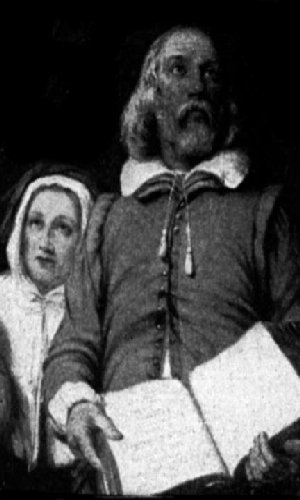Giles Corey was a prosperous farmer and full member of the church. He lived in the southwest corner of Salem village. In April of 1692, he was accused by Ann Putnam, Jr., Mercy Lewis, and Abigail Williams of witchcraft. Ann Putnam claimed that on April 13 the specter of Giles Corey visited her and asked her to write in the Devil's book. Later, Putnam was to claim that a ghost appeared before her to announce that it had been murdered by Corey. Other girls were to describe Corey as "a dreadful wizard" and recount stories of assaults by his specter.
Why Corey was named as a witch (male witches were generally called "wizards" at the time) is a matter of speculation, but Corey and his wife Martha were closely associated with the Porter faction of the village church that had been opposing the Putnam faction. Corey, eighty years old, was also a hard, stubborn man who may have expressed criticism of the witchcraft proceedings.
Corey was examined by magistrates on April 18, then left to languish with his wife in prison for five months awaiting trial. When Corey's case finally went before the grand jury in September, nearly a dozen witnesses came forward with damning evidence such as testimony that Corey was seen serving bread and wine at a witches' sacrament. Corey knew he faced conviction and execution, so he chose to refuse to stand for trial. By avoiding conviction, it became more likely that his farm, which Corey recently deeded to his two sons-in-law, would not become property of the state upon his death.
The penalty for refusing to stand for trial was death by pressing under heavy stones. It was a punishment never before seen in the colony of Massachusetts. On Monday, September 19, Corey was stripped naked, a board placed upon his chest, and then--while his neighbors watched--heavy stones and rocks were piled on the board. Corey pleaded to have more weight added, so that his death might come quickly.
Samuel Sewall reported Corey's death: "About noon, at Salem, Giles Corey was press'd to death for standing mute." Robert Calef, in his report of the event, added a gruesome detail: Giles's "tongue being prest out of his mouth, the Sheriff with his cane forced it in again, when he was dying." Judge Jonathan Corwin ordered Corey buried in an unmarked grave on Gallows Hill.
Corey is often seen as a martyr who "gave back fortitude and courage rather than spite and bewilderment." His very public death may well have played in building public opposition to the witchcraft trials.

